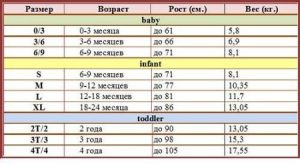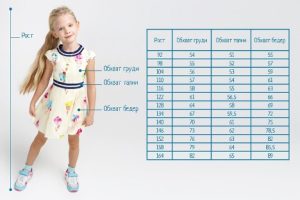
The love for online shopping is becoming increasingly popular among modern people. It’s so simple and convenient: without getting up from your favorite sofa/chair, you can order a huge number of things – from household chemicals to clothes and groceries.
This is especially true for purchasing children's clothing. After all, a small child is growing literally by leaps and bounds! And young mothers do not always have the opportunity to go shopping with their children once again. After all, it is necessary not only to do all the housework, but also to build a career. And here it is online stores that “come” to the rescue.
Foreign clothing stores, European and American, are of particular interest among young mothers. After all, there you can buy not just beautiful and comfortable clothes, but also very fashionable ones (after all, every parent dreams of his child being the most beautiful and fashionable among his peers!). But when choosing clothes, a small problem arises: the discrepancy between the Russian and American sizing charts.
How to convert American sizes to more familiar Russian sizes

The biggest problem when choosing clothes in American stores is the specified parameters. The manufacturer indicates them in inches, and not in centimeters, as is customary in most countries of Europe or Asia. But in children's clothing, American factories indicate only two parameters that can be easily and quickly entered into a search engine. This is the height and age of the child.
All clothing is marked according to this. For example, for children from 0 to 2 years old there will be a “Baby” marker, and from 2 to 8 years old the label will be “Kids”. Within these two markings, you can choose clothes for both boys and girls without much difficulty.
But the “Juniors” label (8-14/15 years old) will make parents tinker. Since here it is already necessary to measure not only height, but also chest volume, waist and hip circumference.
It is also worth paying attention to the letter designations that will come after the number (for example, 9L). They have the following designations:
- M (“medium”) – average.
- L (“Large”) – large. Some manufacturers label this size X. The designation is the same: “large.”
- XL (“extra Large”) – very large. The number of letters before L can be any, depending on the parameters. But in children's clothing this happens very rarely.
What else can help you choose clothes for your child in an American online store?
The exact size chart for each manufacturer must be viewed separately. On the website of the selected online store it can be presented in the Size Chart/ Sizing Guide sections. You can also use a search engine by typing the name of a specific brand into it. The official page should provide a comparison grid of all sizes.
All examples of comparisons of size charts, which are presented in the public domain on Russian portals, should not be taken as “the only and indisputable truth.” The sizes of each manufacturer may vary significantly.
The child is growing very quickly. Therefore, it is worth purchasing clothes a size larger and not too tight.
1 inch equals 2.5 centimeters (approximately). Thanks to this, you can use simple mathematical manipulations to make independent calculations, and ultimately select the required size range.
If numerical parameters are indicated through a fraction (for example, 14/60), therefore, the first digit will indicate the size (according to the American system), and the second height (in inches).
Please note that clothes according to height in American stores are presented for children of standard build! If the child differs from the “standard parameters”, then this should be taken into account when ordering clothes.


 0
0




